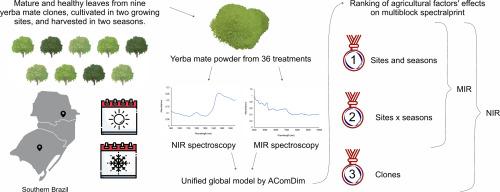Multiblock NIR and MIR spectralprint through AComDim to evaluate the effects of growing site, harvest season, and clone on yerba mate leaves composition
IF 8.5
1区 农林科学
Q1 CHEMISTRY, APPLIED
引用次数: 0
Abstract
The composition of yerba mate implies significant potential in the food, pharmaceutical, and cosmetic industries, which requires standardization of the raw material. This study explores the simultaneous influence of growing sites, harvest seasons, and clones on the spectralprint of leaves through near-infrared (NIR) and mid-infrared (MIR) spectroscopy coupled with ANOVA Common Dimensions (AComDim) multivariate analysis. MIR spectroscopy identifies only the main effects of growing site and harvesting season, and the interaction between these factors. The NIR spectralprint identifies all main effects and interactions. Growing site and harvesting season individually account for approximately 7 % of the variance in the chemical composition of yerba mate, with their interaction contributing with 5.7 %. Clonal variation significantly affects the spectral profile with approximately 4 % variance, which allowed the identification of clones with the highest chemical divergence. The study demonstrates that biospectroscopics and chemometrics can enhance yerba mate quality through clonal selection and optimized agricultural practices.

求助全文
约1分钟内获得全文
求助全文
来源期刊

Food Chemistry
工程技术-食品科技
CiteScore
16.30
自引率
10.20%
发文量
3130
审稿时长
122 days
期刊介绍:
Food Chemistry publishes original research papers dealing with the advancement of the chemistry and biochemistry of foods or the analytical methods/ approach used. All papers should focus on the novelty of the research carried out.
 求助内容:
求助内容: 应助结果提醒方式:
应助结果提醒方式:


